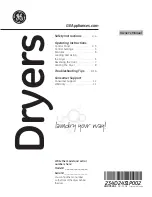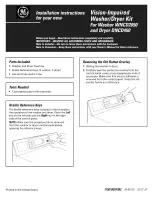
20
BRIGGSandSTRATTON.COM
6. Using a garden hose, remove additional debris by back
flushing water through nozzle extension. Back flush
between 30 to 60 seconds.
7. Reinstall nozzle into nozzle extension.
8. Reconnect nozzle extension to spray gun.
9. Make sure garden hose is connected to water inlet.
Check that high pressure hose is connected to spray
gun and pump. Turn on water.
10. Engage trigger lock on spray gun and start engine
following instructions
How to Start Your Pressure
Washer
.
11. Test pressure washer by operating with each quick
connect nozzle.
O-Ring Maintenance
Purchase an O-Ring / Maintenance Kit, model 6048, by
contacting the nearest authorized Briggs & Stratton service
center. It is not included with the pressure washer. This kit
includes replacement o-rings, rubber washer and water inlet
filter. Refer to the instruction sheet provided in the kit to
service your unit’s o-rings.
Engine Maintenance
Oil
Oil Recommendations
We recommend the use of Briggs & Stratton Warranty
Certified oils for best performance. Other high-quality
detergent oils are acceptable if classified for service SF, SG,
SH, SJ or higher. DO NOT use special additives.
Outdoor temperatures determine the proper oil viscosity for
the engine. Use the chart to select the best viscosity for the
outdoor temperature range expected.
* Below 40°F (4°C) the use of SAE 30 will result in hard starting.
** Above 80°F (27°C) the use of 10W30 may cause increased oil
consumption. Check oil level more frequently.
NOTE:
Synthetic oil meeting ILSAC GF-2, API
certification mark and API service symbol with
“SJ / CF ENERGY CONSERVING” or higher, is an
acceptable oil at all temperatures. Use of synthetic
oil does not alter required oil change intervals.
WARNING
The high pressure stream of water that this
equipment produces can cut through skin and its
underlying tissues, leading to serious injury and
possible amputation.
• NEVER repair leaking connections with sealant of any kind.
Replace o-ring or seal.
WARNING
Unintentional sparking can result in fire or
electric shock.
WHEN ADJUSTING OR MAKING REPAIRS TO YOUR PRESSURE
WASHER
• Disconnect the spark plug wire from the spark plug and place
the wire where it cannot contact spark plug.
WHEN TESTING FOR ENGINE SPARK
• Use approved spark plug tester.
• DO NOT check for spark with spark plug removed.
















































